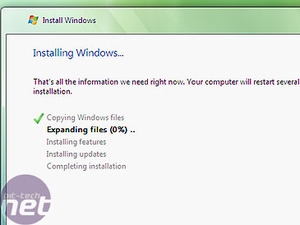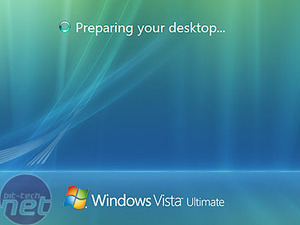
Well, Windows Vista is finally here. It's been many years since we first heard about the existence of Longhorn, the original codename for Vista, and at the time, nobody thought it would take until January 2007 for us to be writing these words. Windows Vista has had a troubled gestation, but from today, you can buy on the shelves (virtual or otherwise) of your favourite computing retailer. There's just one question - should you get it?
We want to answer that question, at least in part, today. Our approach is slightly different from much of the mainstream press, since the criteria that enthusiasts like us look for in an operating system are going to be very different from Joe Public. Over the next few pages, we're going to be showing you the new features of Vista, as well as looking at performance relative to XP, benchmarks and hardware compatibility. In a second part to this article, next week, we're going to be taking a detailed look at gaming performance. So, don't despair - we'll be firing up our 8800s soon, stay tuned.
The name 'Vista' was officially given to it in July 2005, when the Longhorn moniker was dropped and the first tentative release dates were given. The general public expected to have Vista shipping on their Christmas presents in 2006 - but this idea was later dropped, and the final date of January 30 was given.
 In the time since Vista was originally power pointed and its release, it's been a lot of things to a lot of people, and ceased to be some, too. Originally in the spec doc was a brand new file system, called WinFS, based on SQL. Such a file system would replace FAT32 and NTFS, and would be fully relational, allowing for fantastic queries and functionality within the operating system that would be revolutionary. The file system proved to difficult to implement, and was shelved.
In the time since Vista was originally power pointed and its release, it's been a lot of things to a lot of people, and ceased to be some, too. Originally in the spec doc was a brand new file system, called WinFS, based on SQL. Such a file system would replace FAT32 and NTFS, and would be fully relational, allowing for fantastic queries and functionality within the operating system that would be revolutionary. The file system proved to difficult to implement, and was shelved.
A new command line shell, codenamed Monad, was also built and then shelved, due to security concerns. The visual look of Vista went through many revisions, and whilst IE7 now supports RSS feeds, an operating system layer designed to integrate such feeds was also trashed during development.
What we have today is, critics argue, a flashier version of XP. If so many new features are gone, what is left? Well, there's plenty, including new security features, performance benefits, shell tweaks and applications. But, first things first - you need to buy Vista and get it installed. What are your options?
Additionally, each of these editions has 32-bit and 64-bit variants. You get both for the same price, but which you install will very much depend on the kind of Vista experience you are looking to have. More on that later.
There are a couple of things about Vista. Most RAID controllers won't need the 'F6 to insert floppy', and should be picked up by Vista's installer, making for an easier life. USB devices are better recognised than the XP installation, and the overall experience is rather slicker. Here are some installation screenshots:
We want to answer that question, at least in part, today. Our approach is slightly different from much of the mainstream press, since the criteria that enthusiasts like us look for in an operating system are going to be very different from Joe Public. Over the next few pages, we're going to be showing you the new features of Vista, as well as looking at performance relative to XP, benchmarks and hardware compatibility. In a second part to this article, next week, we're going to be taking a detailed look at gaming performance. So, don't despair - we'll be firing up our 8800s soon, stay tuned.
History repeating
Let's start with a quick recap of Vista. It was first mooted back in 2001, before Windows XP had even shipped. Development was rerouted in a new direction in 2004, after problems with the approach to programming the operating system emerged, and 'feature creep' became a major problem.The name 'Vista' was officially given to it in July 2005, when the Longhorn moniker was dropped and the first tentative release dates were given. The general public expected to have Vista shipping on their Christmas presents in 2006 - but this idea was later dropped, and the final date of January 30 was given.

A new command line shell, codenamed Monad, was also built and then shelved, due to security concerns. The visual look of Vista went through many revisions, and whilst IE7 now supports RSS feeds, an operating system layer designed to integrate such feeds was also trashed during development.
What we have today is, critics argue, a flashier version of XP. If so many new features are gone, what is left? Well, there's plenty, including new security features, performance benefits, shell tweaks and applications. But, first things first - you need to buy Vista and get it installed. What are your options?
The Windows Vista puzzlebox
There are a number of different versions of Vista, all of which cost different amounts of money and have different feature sets. Here's a quick recap of the differences:Vista Home Basic:
The bare bones product. Don't even bother - you won't get much of a difference over XP. £175 Full version, £90 Upgrade.Vista Home Premium:
This is the version most people will end up with. It includes Media Center support, as well as HDTV support, DVD authoring software and better hardware support, such as for SideShow displays and touch screens. £210 Full version, £140 Upgrade.Vista Business and Enterprise Editions:
We suspect that you're probably not going to be installing these two. Aside from being more expensive than Home Premium, it includes a lot of things you won't need - the IIS web server, faxing. £250 Full version, £170 Upgrade.Vista Ultimate Edition:
This is the big daddy version, which has everything that Vista has to offer. You get all the hardware support, Media Center, as well as extra games and such. You can get software to use full-motion video as a desktop background. BitLocker encryption is included, as well as WinSAT, which claims to be a game performance tweaker. £350 Full version, £230 Upgrade.Additionally, each of these editions has 32-bit and 64-bit variants. You get both for the same price, but which you install will very much depend on the kind of Vista experience you are looking to have. More on that later.
A note on OEM software:
It has long been the case that cheaper, licensed versions of Microsoft software have been purchased by enthusiasts building their own systems. Generally, you are entitled to buy OEM / system builder editions of MS operating systems if you're buying hardware, such as a hard drive, at the same time. You don't get retail packaging, just the disc, but you do get a legit key. There is a massive difference in price - the full version of Vista Ultimate can be had for around £130 on an OEM deal, and Home Premium for £75. Unless you have a distinct reason to buy retail, we'd suggest going with an OEM version. However, do note that once you've installed an OEM copy of Vista, the license agreement prevents you installing it on another machine. Upgrades, however, are permitted.Installation
We grabbed our copy of Ultimate Edition and set about installing it on our test machine.There are a couple of things about Vista. Most RAID controllers won't need the 'F6 to insert floppy', and should be picked up by Vista's installer, making for an easier life. USB devices are better recognised than the XP installation, and the overall experience is rather slicker. Here are some installation screenshots:

MSI MPG Velox 100R Chassis Review
October 14 2021 | 15:04












Want to comment? Please log in.